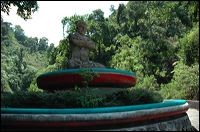Gajah
Mada
 According
to the Nagarakertagama, and supported by inscriptions
dating from the late 13th and early 14th centuries,
Raden Wijaya Sri Kertarajasa Jayawardhana married
the four daughters of Kertanagara. From his
eldest and principal queen, Dyah Dewi Tribhuwaneshwari,
was born a son, Jayanagara, who succeeded to
the throne on his father's death in 1309. According
to the Nagarakertagama, and supported by inscriptions
dating from the late 13th and early 14th centuries,
Raden Wijaya Sri Kertarajasa Jayawardhana married
the four daughters of Kertanagara. From his
eldest and principal queen, Dyah Dewi Tribhuwaneshwari,
was born a son, Jayanagara, who succeeded to
the throne on his father's death in 1309.
During the reigns of both Kertarajasa and Jayanagara
the focus was on the establishment of stability
within the new state. Numerous uprisings occurred,
all of which were put down successfully, though
not without cost of lives. Then, in 1328, Jayanagara
was assassinated. It is said that he was overprotective
towards his two half sisters, born from Kertarajasa's
youngest queen, Dyah Dewi Gayatri. Complaints
lodged by the two young princesses led to the
intervention of Gajah Mada, the talented minister
who was later to take Majapahit to the height
of its glory. He arranged for a surgeon to murder
the king while pretending to perform an operation
With the death of Jayanagara the throne of Majapahit
was without a direct male heir. The position
was occupied instead by the eldest of the deceased
king's two sisters, Tribhuwana Wijayatungga Dewi,
who ruled until 1350. By that time her son, Hayam
Wuruk, who had been born in 1334, became old
enough to take over. During his reign, as well
as that of his mother, effective power was in
the hands of Gajah Mada, who had been appointed
prime minister and commander-in chief.
Gajah Mada stands among the greatest of Indonesia's
heroes. From the time when he swore his famous
oath of allegiance, the Sumpah Palapa, until
his death in 1364, a period of just 28 years,
he succeeded in spreading the power and influence
of Majapahit throughout the archipelago, and
even beyond the boundaries of the present day
Republic of Indonesia.
|
|
The
waterfall Madakaripura, to the south
of Probolinggo, is believed to have
been a part of an area of land granted
to Gajah Mada by Hayam Wuruk. According
to tradition, it was here that Gajah
Mada formulated his famous oath of
allegiance, the Sumpah Palapa, in
which be vowed to unite the Indonesian
archipelago. |
Click Here...
Photos Gallery
More
information about Mojo Fruit, please Click
here.. |













